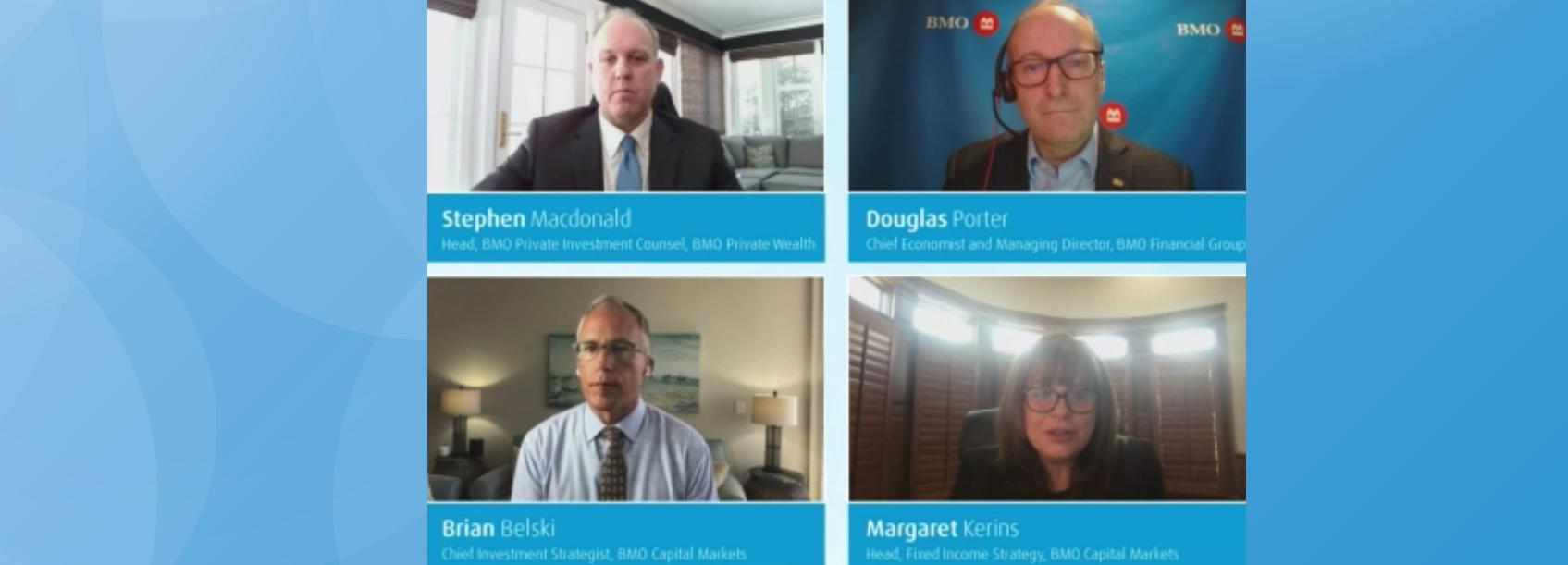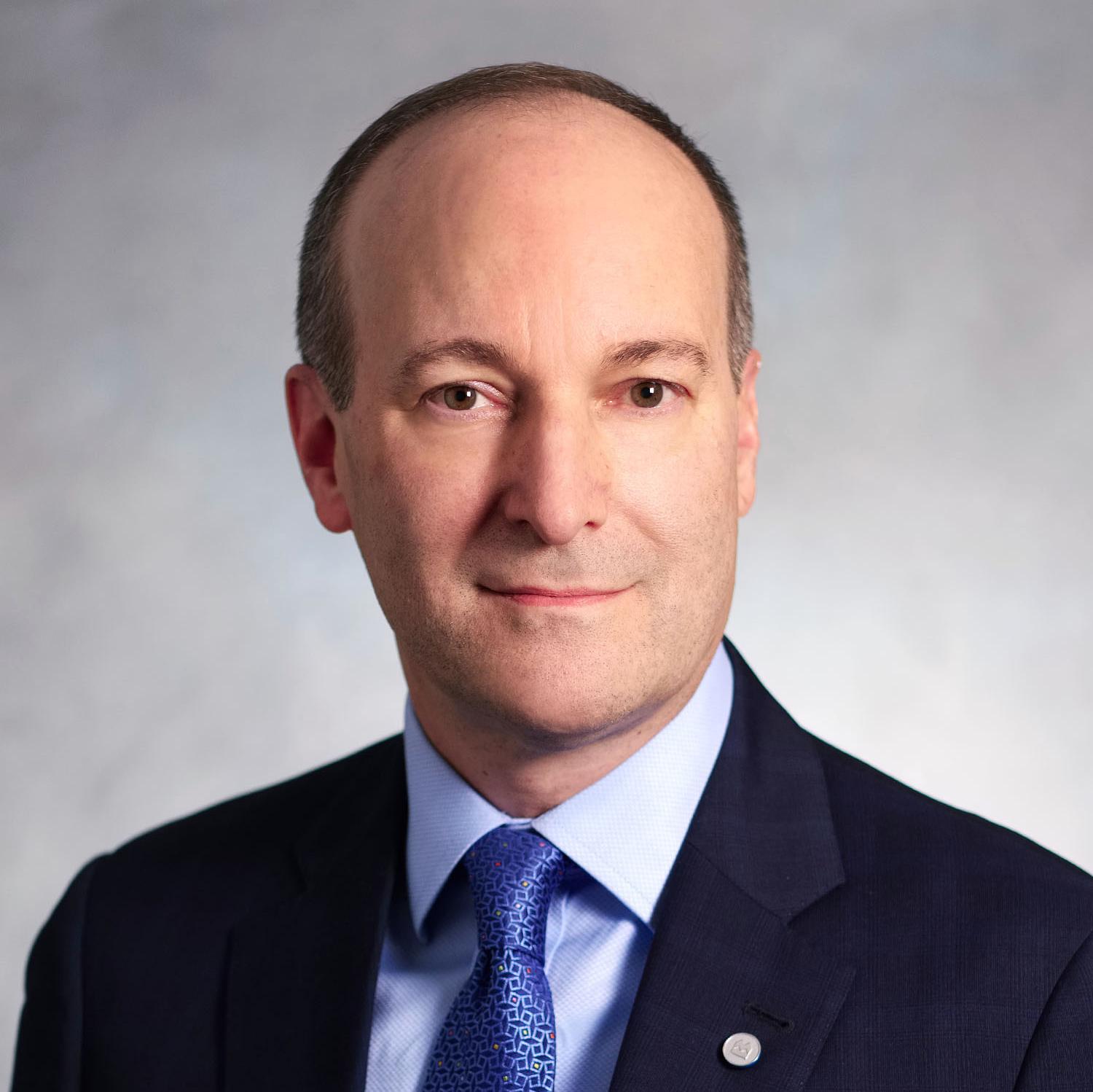
Russia’s Invasion: Economic and Market Impacts
-
bookmark
-
print
Russia’s invasion of Ukraine could dampen the high expectations for economic growth this year and add to global inflationary pressures, with a spike in oil prices representing the “single biggest risk” to the economy and to investors, said a panel of BMO experts on Monday.
The panel, Russia’s Invasion: Economic and Market Impacts, featured Douglas Porter, BMO Financial Group’s Chief Economist and Managing Director, Margaret Kerins, Head of FICC Macro Strategy at BMO Capital Markets, Brian Belski, Chief Investment Strategist at BMO Capital Markets, and moderator Stephen Macdonald, Head of BMO Private Investment Counsel at BMO Private Wealth.
According to Douglas Porter, every $10 (US) increase in the price of a barrel of oil adds almost half a percentage point to the rate of inflation, which is a major concern given today’s “fraught inflationary backdrop,” he said.
Still, the panelists were optimistic that the geopolitical uncertainty would subside and that 2022 would remain a generally positive year for North American equities. “We’re bullish,” noted Brian Belski. “We’ve not changed our forecast and we will not give in to the reactive nature of the market. We still see the same trends that we did (a few months ago).”
One of the more immediate impacts of the Ukraine situation is that it has “skimmed away the chance of the Bank of Canada being more aggressive” in its efforts to fight inflation with interest rate hikes, said Porter.
The central bank will likely announce a 0.25 percentage point increase in the overnight lending rate when it meets on March 2nd, with the Federal Reserve following a couple of weeks later, but it won’t increase rates six or seven times this year, as some have predicted. Porter foresees four more rate hikes over the course of the year – and then hiking roughly once per quarter.
“At the margin, (the conflict) may have dulled the overall amount of rate increases that the Bank of Canada might do in the year ahead,” he said.
Inflation to remain high
“Generally, Canadians can expect inflation to eventually moderate to within the 4% to 5% range, with GDP growth coming in at around 4%,” Porter said. He also added the Canadian dollar, which has depreciated slightly against the greenback in recent months, has become untethered from oil prices. That’s good news for energy producers, whose revenues fully benefit as oil prices rise, but not for consumers.
“That’s why we’re looking at record gasoline prices in Canada at a time when oil prices are still nowhere close to record highs,” Porter said. He anticipates housing will stay strong through gradual increases in interest rates, and it could even see some “safe-haven inflows” as investors seek to shelter their capital in turbulent times.
What he doesn’t foresee is broad-based tax hikes to pay down debt incurred because of the pandemic. Remarkably, the federal government ran a surplus in December, an indication that government revenues “have completely repaired themselves in this country” since the start of the COVID-19 outbreak, he said.
Better markets ahead
As for fixed income, the crisis certainly “adds another element of risk in the decision-making for those in the markets, and all of this has been seen by elevated intraday volatility in rates and in risk assets,” said Margaret Kerins.
Over the past week, the 10-year Treasury yield retreated from its recent 2% plus peak, but Kerins still thinks it’ll top 2.25% by year end. “Once the geopolitical risk subsides, the credit market will begin to trade in a range again,” she said. “We’ll see better buying emerge there.”
With equities, Belski predicted an ongoing “transition to normalcy” as the momentum-driven markets of the past four or five years give way to markets driven by fundamentals. Despite all the noise around inflation and interest rates, earnings growth continues to impress.
“The market’s done its job with respect to tech,” he said, referring to the repricing of technology stocks, especially those whose expected profits lie far in the future. He also added that markets have corrected by more than 10%. Whenever that’s happened – as it has 29 times since 1970 – stocks have rebounded, on average, by 27% in the 12 months following the bottom.
Geopolitical issues have also not changed his view of Canada and the U.S. being the best markets for equities. The eurozone, by contrast, has been something of a value trap for the past 20 years, with its share of global output falling by 12 percentage points. “Investors should consider an active strategy of buying single stocks and single-country ETFs rather than a blanket European or EAFE index fund when investing outside North America,” he said.
As for sectors, Belski expressed favour for bank stocks and materials while remaining neutral on energy, which saw a significant run-up over the past year. In light of geopolitical tensions, “I think materials are exquisitely positioned in both Canada and the U.S. for the next 12 to 18 months,” he said. BMO also has a favourable view of technology, communications, industrials and consumer discretionary stocks.
In the medium term, Porter cautioned that decarbonization could pose some downside risk to the Canadian economy, with some provinces still dependent on revenue from fossil fuel production and consumption. As carbon taxes rise higher, some of these provinces and industries are going to suffer. “It is a huge challenge for the Canadian economy,” he said.
Whatever happens in Ukraine, the main theme for 2022 will continue to be around taming inflation with rising interest rates. “There are all these unknown risks, but we do think the market will settle down and re-engage with economic fundamentals, the Fed tightening and balance sheet runoff,” said Kerins. “So rates should start moving higher once again at the long end of the curve.”

Russia’s Invasion: Economic and Market Impacts
Managing Director & Chief Economist
Douglas Porter has over 30 years of experience analyzing global economies and financial markets. As Chief Economist at BMO Financial Group and author of the popular…
Chief Investment Strategist
Brian, Chief Investment Strategist and leader of the Investment Strategy Group, provides strategic investment and portfolio management advice to both institutional …
Douglas Porter has over 30 years of experience analyzing global economies and financial markets. As Chief Economist at BMO Financial Group and author of the popular…
VIEW FULL PROFILEBrian, Chief Investment Strategist and leader of the Investment Strategy Group, provides strategic investment and portfolio management advice to both institutional …
VIEW FULL PROFILE-
Minute Read
-
Listen
Stop
-
Text Bigger | Text Smaller
Russia’s invasion of Ukraine could dampen the high expectations for economic growth this year and add to global inflationary pressures, with a spike in oil prices representing the “single biggest risk” to the economy and to investors, said a panel of BMO experts on Monday.
The panel, Russia’s Invasion: Economic and Market Impacts, featured Douglas Porter, BMO Financial Group’s Chief Economist and Managing Director, Margaret Kerins, Head of FICC Macro Strategy at BMO Capital Markets, Brian Belski, Chief Investment Strategist at BMO Capital Markets, and moderator Stephen Macdonald, Head of BMO Private Investment Counsel at BMO Private Wealth.
According to Douglas Porter, every $10 (US) increase in the price of a barrel of oil adds almost half a percentage point to the rate of inflation, which is a major concern given today’s “fraught inflationary backdrop,” he said.
Still, the panelists were optimistic that the geopolitical uncertainty would subside and that 2022 would remain a generally positive year for North American equities. “We’re bullish,” noted Brian Belski. “We’ve not changed our forecast and we will not give in to the reactive nature of the market. We still see the same trends that we did (a few months ago).”
One of the more immediate impacts of the Ukraine situation is that it has “skimmed away the chance of the Bank of Canada being more aggressive” in its efforts to fight inflation with interest rate hikes, said Porter.
The central bank will likely announce a 0.25 percentage point increase in the overnight lending rate when it meets on March 2nd, with the Federal Reserve following a couple of weeks later, but it won’t increase rates six or seven times this year, as some have predicted. Porter foresees four more rate hikes over the course of the year – and then hiking roughly once per quarter.
“At the margin, (the conflict) may have dulled the overall amount of rate increases that the Bank of Canada might do in the year ahead,” he said.
Inflation to remain high
“Generally, Canadians can expect inflation to eventually moderate to within the 4% to 5% range, with GDP growth coming in at around 4%,” Porter said. He also added the Canadian dollar, which has depreciated slightly against the greenback in recent months, has become untethered from oil prices. That’s good news for energy producers, whose revenues fully benefit as oil prices rise, but not for consumers.
“That’s why we’re looking at record gasoline prices in Canada at a time when oil prices are still nowhere close to record highs,” Porter said. He anticipates housing will stay strong through gradual increases in interest rates, and it could even see some “safe-haven inflows” as investors seek to shelter their capital in turbulent times.
What he doesn’t foresee is broad-based tax hikes to pay down debt incurred because of the pandemic. Remarkably, the federal government ran a surplus in December, an indication that government revenues “have completely repaired themselves in this country” since the start of the COVID-19 outbreak, he said.
Better markets ahead
As for fixed income, the crisis certainly “adds another element of risk in the decision-making for those in the markets, and all of this has been seen by elevated intraday volatility in rates and in risk assets,” said Margaret Kerins.
Over the past week, the 10-year Treasury yield retreated from its recent 2% plus peak, but Kerins still thinks it’ll top 2.25% by year end. “Once the geopolitical risk subsides, the credit market will begin to trade in a range again,” she said. “We’ll see better buying emerge there.”
With equities, Belski predicted an ongoing “transition to normalcy” as the momentum-driven markets of the past four or five years give way to markets driven by fundamentals. Despite all the noise around inflation and interest rates, earnings growth continues to impress.
“The market’s done its job with respect to tech,” he said, referring to the repricing of technology stocks, especially those whose expected profits lie far in the future. He also added that markets have corrected by more than 10%. Whenever that’s happened – as it has 29 times since 1970 – stocks have rebounded, on average, by 27% in the 12 months following the bottom.
Geopolitical issues have also not changed his view of Canada and the U.S. being the best markets for equities. The eurozone, by contrast, has been something of a value trap for the past 20 years, with its share of global output falling by 12 percentage points. “Investors should consider an active strategy of buying single stocks and single-country ETFs rather than a blanket European or EAFE index fund when investing outside North America,” he said.
As for sectors, Belski expressed favour for bank stocks and materials while remaining neutral on energy, which saw a significant run-up over the past year. In light of geopolitical tensions, “I think materials are exquisitely positioned in both Canada and the U.S. for the next 12 to 18 months,” he said. BMO also has a favourable view of technology, communications, industrials and consumer discretionary stocks.
In the medium term, Porter cautioned that decarbonization could pose some downside risk to the Canadian economy, with some provinces still dependent on revenue from fossil fuel production and consumption. As carbon taxes rise higher, some of these provinces and industries are going to suffer. “It is a huge challenge for the Canadian economy,” he said.
Whatever happens in Ukraine, the main theme for 2022 will continue to be around taming inflation with rising interest rates. “There are all these unknown risks, but we do think the market will settle down and re-engage with economic fundamentals, the Fed tightening and balance sheet runoff,” said Kerins. “So rates should start moving higher once again at the long end of the curve.”
You might also be interested in
IN Tune: The AI + Data Center Build Out: Sustainability Impacts, Second Order Beneficiaries
Food, Ag, Fertilizer, and ESG From BMO’s 19th Annual Farm to Market Conference: BMO Equity Research
IN Tune: Food, Ag, Fertilizer, and ESG From BMO’s 19th Annual Farm to Market Conference
IN Tune: Investment Ideas for Climate Change: Discussing the BMO Climate Opportunities Screen
Federal Budget 2024: Capital Gains Taxes Climb; Some Nuggets for Entrepreneurs
Inaugural BMO Obesity Summit Focuses on Therapeutics and Combating a Growing Epidemic
BMO Blue Book: U.S. Economy is Resilient but Predicted to Slow in Early 2024
The Age of Transparency: Companies Poised to Benefit as Reporting Rules Tighten
Breaking Down the Food Waste Problem: Big Inefficiencies = Big Opportunity
ESG Thoughts of the Week from BMO Equity Research: Wildfire Risk, CAT Losses Increasing

Food, Ag, Fertilizer, and ESG From BMO’s 18th Annual Farm to Market Conference
Energy Transition Will Require Collaboration Between Miners and End-Users
Will 2023 be the Year of Gold: World Gold Council at BMO Conference
Top Rankings for BMO Capital Markets' FICC Macro Strategy Group in Institutional Investor Client Survey
The Market Transition from COVID-19 has Begun: Belski to BMO Metals and Mining Conference













